Why We Love DC Comics’ Bizarre, Surrealist Take on Hanna-Barbera Cartoons
Comics Features Hanna-Barbera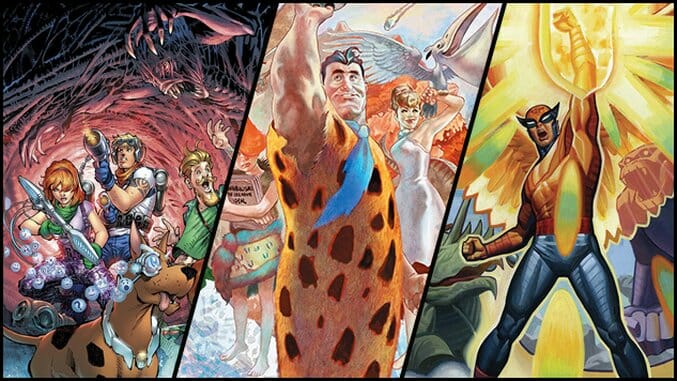
When perusing the weekly stacks of DC comics, I never expected to pass over Batman, Superman, Justice League and other iconic superhero tentpoles for sequential art renditions of Scooby-Doo, The Flintstones and Wacky Racers. Yet here we are. It’s hard to fathom how anyone at the publisher of the Bat let the idea of turning ‘60s classic cartoons into mature, violent and bizarre comics pass through a single meeting, but these tales made it all the way to your local comic store.
“We had the ability to bring up the full catalog of Hanna-Barbera characters in a way that allowed us a lot of creative freedom to really re-imagine and present them in a new light, which would hopefully attract both a new audience and the original audience,” DC Comics Co-Publisher Dan DiDio said.
“It just starts with a conversation. What can we do with this IP, with these characters, that hasn’t been done before?” Jim Lee, also a Co-Publisher at DC, elaborated. “We’re already publishing a line of Scooby books aimed at kids, and we started thinking about what would happen if the monsters were real and the Scooby gang had to save the world. That kind of creative spark and riffing back and forth lead to us re-envisioning the Scooby universe in an apocalyptic fashion. It’s still very much the same personalities and the same dynamic between the characters, it’s just revamped for contemporary times.”
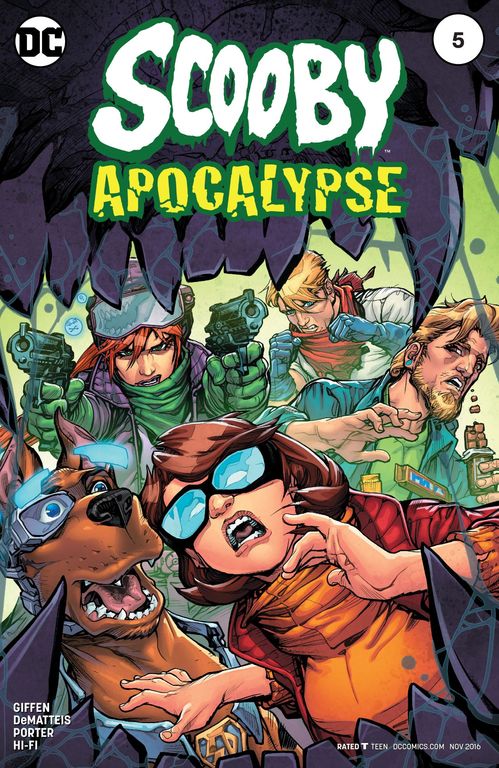
Scooby Apocalypse #5 Cover Art by Howard Porter
I, for one, am damn near ecstatic DC took the chance to do something crazy. The publisher’s takes on Future Quest (a medley of different properties including Jonny Quest, Birdman and Space Ghost), Scooby-Doo, The Flintstones and Wacky Races incorporate mature, surprising twists on licenses that have stood stolid for decades. Much like Jason Segel and James Bobin’s 2011 Muppets film revamp, these comics transcend adolescent audiences, designed for the kids who grew up watching these shows decades ago—kids who have grown into the cynicism of adulthood, while maintaining nostalgia for their childhood.
Personally, I always hated the founding Scooby-Doo cartoon. Every episode had an identical plot structure and Shaggy’s stoner mentality drove me nuts. (Murderous mummy chasing you? Perfect time to stop for a sandwich!) So maybe that’s why Scooby Apocalypse is far more intriguing. Shaggy is now a bearded, swarthy lumbersexual, but his emotional relationship with the cybernetic, ultra-smart Scooby still feels surprisingly genuine. Also: Scrappy Doo is just a damned evil asshole.
The creative team of J.M. DeMatteis, Keith Giffen, Howard Porter and Dale Eaglesham have created various analogs to the old cartoon, executed in a way that works for a true survival-horror story. Daphne is a beautiful, capable rich girl turned guerrilla journalist; Fred is her puppy-dog-like cameraman, who’s pathetically in love with her—much to her annoyance and dismay. The authors reinterpret Velma as a scientist who unwittingly helped unleash the titular nanite apocalypse that’s turned the general population into hideous monsters. The Mystery Machine? Now a badass armored vehicle.
Scooby Apocalypse creates humor in the periphery, but handles its doomsday premise with surprising maturity. In an ingenious twist on the old “villains in rubber monster masks” trope, the story never shies away from the fact that these man-eating monstrosities were people… with names, families, hopes and dreams. Daphne, in particular, is cognizant that every time the gang mows one of them down, they’re murdering someone.

Scooby Apocalypse #3 Interior Art by Dale Eaglesham
Its third issue out next week, the title offers a welcome level of depth, shifting these long-time characters into personalities miles away from two-dimensional toons. Thrown together into this nightmare, the Scooby Gang is also far from a working team at this point. Daphne and Velma constantly bicker—Daphne blames Velma for the apocalypse as she worked with the scientists who presumably caused it. Fred does his best to heroically impress Daphne (and not die), while Shaggy and Scooby strive to not fall apart amidst inner and outer turmoil.
It’s not a stretch to say this comic is an innovative highpoint for the property, but diehard fans of the old show might be jolted by the gritty and realistic perspective.
In similar fashion, the lighthearted cartoon romp Wacky Races has been transformed into violence-filled death race called Wacky Raceland, by writer Ken Pontac and artist Leonardo Manco, that draws immediate parallels to Mad Max: Fury Road. DiDio agreed with the connection, making analogues between the books and their pop culture-infused inspirations. “If you look at it, it’s Scooby-Doo/Walking Dead, Wacky Raceland/Mad Max,” he explained. “Some people said Flintstones/Mad Men, which makes me laugh, but alright. Each one takes sensibilities from these types of stories that are playing in pop culture and modern society.”
Dick Dastardly and Muttley, the villains of the cartoon, have been transformed into, respectively, a crazy redneck drifter who’s more antihero than evildoer and his vicious cyborg dog. In Wacky Raceland, the duo and their competition reveal layers unexplored in the kitschy source material. Penelope Pitstop is a dominatrix adorned in pink latex who beats down mutant misogynists, thus spreading the violent word of feminism in a bleak future. The series projects a distinct sense of social injustice through its flooded apocalypse; mutants and cyborgs (and dogs) are prejudiced against in bars, but racing through the open landscape, everyone is equal.
The cars are also self-aware and tend to hate their drivers and flirt with one another. They might be as interesting as their human partners, but time will tell if Pontac explores this strange facet of the comic. Manco’s art is sharp, but chaotic. At times the action is, by design, hard to follow, creating a sense of utter pandemonium during the races and action sequences.
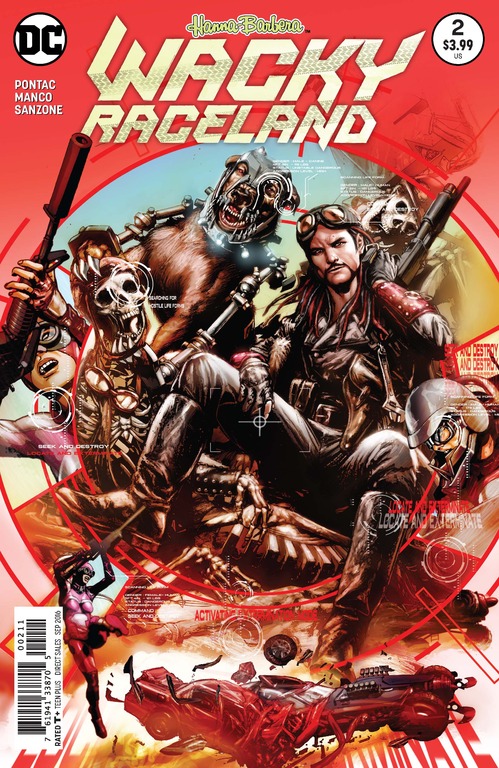
Wacky Raceland #2 Cover Art by Leonardo Manco
Wacky Raceland is the only limited series in the line, completing with six issues, but DC is already working on ways to expand the universe. Preacher and Hitman co-creator Garth Ennis is actively working on a Dastardly and Muttley run, an interesting development given the extreme violence of Ennis’ previous work and the kid-friendly origin of these characters.
“Garth is an incredibly talented writer and we’re happy to have him back at DC,” Didio said about the contrast. “Dastardly and Muttley are possibly his favorite cartoon characters of all time. He loves the characters and I think no matter how crazy it may seem, you’ll get a true sense of love for the characters from the people working on it, and I think that’s what makes his book so good.”
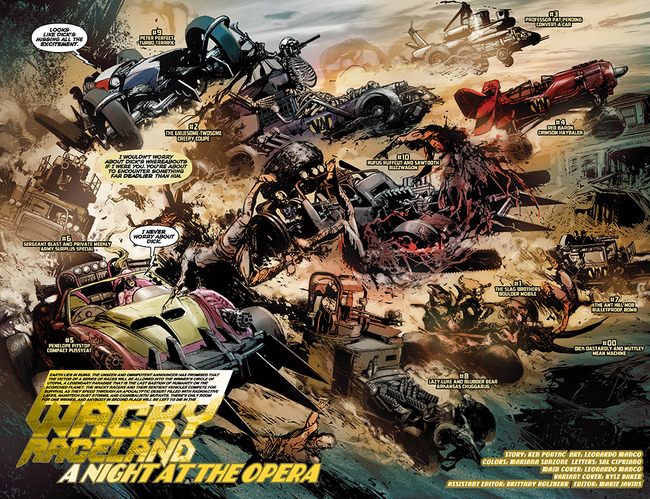
Wacky Raceland #2 Interior Art by Leonardo Manco
Future Quest is the most traditional of the four, combining Jonny Quest, Space Ghost, Birdman and a host of other familiar characters into a blender. The comic, written by Jeff Parker and illustrated by Evan “Doc” Shaner and Steve Rude, unfolds through a labyrinth of narrative structures. “That allows us to mix it up,” DiDio said. “We can allow the characters to team up and have solo adventures as well. There are so many characters and we have so much potential with this series.”
Future Quest is almost too dense to keep up with, switching between characters, time lines and perspectives constantly. It’s no easy feat to combine this many characters across vastly different worlds, but somehow the comic manages to end up being a fascinating old-school adventure featuring boy explorers, traditional cliff-hangers, lava shooting dinos, superheroes, aliens and ‘50s science heroes.
The overall themes, art and action are all heavily reminiscent of the original Hanna-Barbera cartoons, but done in a more modern way. Future Quest doesn’t hold your hand in over-explaining its origins and relies on having some familiarity with the characters. It’s a refreshing take on common tropes used in both cartoons and standard superhero comic, but in a distinctly upbeat, tongue-in-cheek way. This is also the only one of the bunch that could be considered “kid-friendly.”
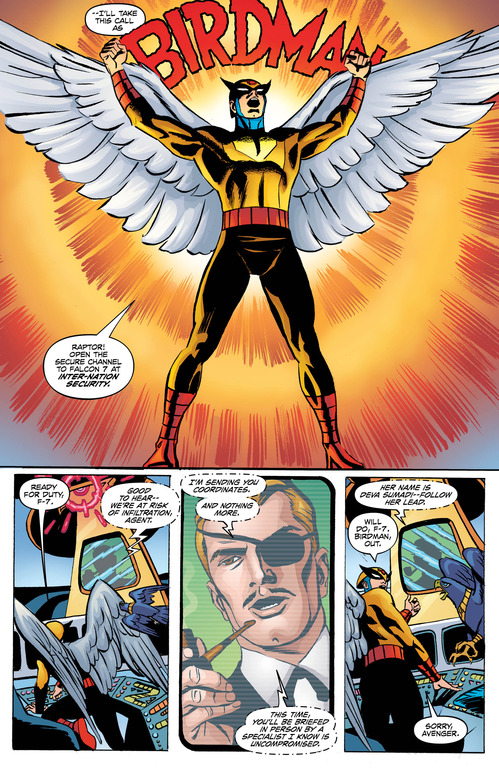
Future Quest #3 Interior Art by Steve Rude
The fourth and final title in the launch, The Flintstones, takes the Honeymooners via cavemen cartoon series and turns it into an existential morality play about class, racism, bored housewives and being a miserable mid-life male.
Writer Mark Russell and artist Steve Pugh frame a scene, for instance, in which employee-of-the-month Fred is charged with training the new, uber-strong Neanderthal recruits, whom his boss is obsessed with hiring. After all, they work for next to nothing and are as strong as three regular men. When one of the recruits asks Fred why he wears a tie, he responds with the old adage to “dress for the job you want, not the one you have.”
“How long have you been doing that?” they ask.
“16 years,” Fred answers with a distinct look of anger and regret on his face.
“‘Miserable mid-life male’ is my specialty,” Russell explained. “I got a call from Dan DiDio who asked me if I was interested in writing it. I think he had me in mind because of the work I did on Prez, which was basically social satire, and that was the angle he wanted to go with The Flintstones, too. To be fair, DC knew what it was getting into when they asked me to write it,” Russell continued. “They can’t claim to be surprised now, because I’m writing it the same way I wrote Prez, which is biting, satiric and to a large extent an examination of human misery.”
The result is, frankly, bizarre brilliance. For readers of a certain age, Russel and Pugh’s reorientation of The Flintstones into a darkly humorous mirror of middle-class drudgery is easily one of the most compelling and interesting comics in a long while. Neanderthals struggle to cope with the more-evolved Homo sapiens, incapable of understanding their obsession with wanton commercialism and destruction. Fred and Barney attend veteran coping meetings to come to terms with the awful things they did to their “lesser” cousins during the Paleolithic wars, which were, it seems, really just mass genocide.
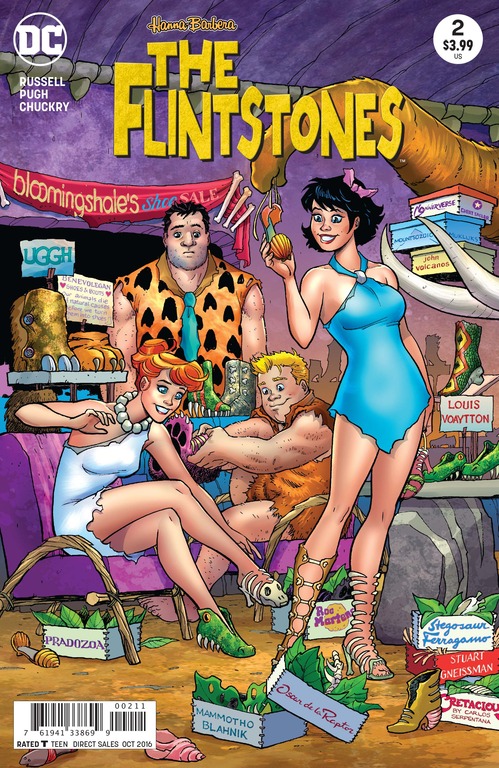
The Flintstones #2 Cover Art by Amanda Conner
“The original Order of the Water Buffalo was very much about the time and place of the ‘50s and ‘60s,” Russell said. “This place where guys could get away from their wives and play poker. I didn’t feel like that was very relevant to our society now. Now, I felt what’s relevant is the plight of veterans returning from war and that we haven’t done much to facilitate their return. Oftentimes, we’ve left them in a lurch and haven’t fulfilled our promises to them.”
Another dark area the comic delves into is the societal obsession to acquire more material possessions, or as the comic literally calls it, “crap.” In the original cartoon, animal labor replaced the boons of modern technology in commonplace items like cameras and garbage disposals. “Whenever Fred takes a picture of someone, a little bird comes out and chisels a picture on a little stone slate,” Mark explained. “It occurs to you that, ‘Wait a minute, that bird has to live its entire life inside this tiny camera’. So, basically the entire Flintstones universe and their consumerism aref based on the fact that someone is okay with consigning this little bird to live its entire life inside this camera. Or a mastodon living under the sink and never seeing daylight—it lives its entire life as a garbage disposal. It’s a really apt metaphor for modern civilization; that all our labor-saving devices, our technology and luxury are based on the fact that everyone is okay with someone living under the sink to make it all possible.”
Russell is using the comic to examine a civilization where humans have gone wrong. “Ironically the things that are the most important to us are the things we tend to think the least about: our religion, immediate surroundings, our politics, our core beliefs and values,” he said. “This is kind of pretentious for a Flintstones comic book, but I really want it to be a platform for people to be able to find the humor in our own civilization and to think about ways in which we might have done a little better.”
DiDio and Lee have big plans for the future of these books. A Jetsons comic by the Harley Quinn team of Amanda Conner and Jimmy Palmiotti will be the next Hanna-Barbera cartoon to receive the DC comic treatment. “We spend a lot of time talking about these books and we really want to make sure we’re doing the best thing possible with every one of these series,” DiDio said. “So, we realize that we can’t get too far away from who these characters are, but at the same time, we can contemporize them in a way that really plays to social themes and makes these characters relevant for today’s reader. If we can find ways to move them forward while still seeming true to their core and still add what’s happening in our world today, that’s a big win.”
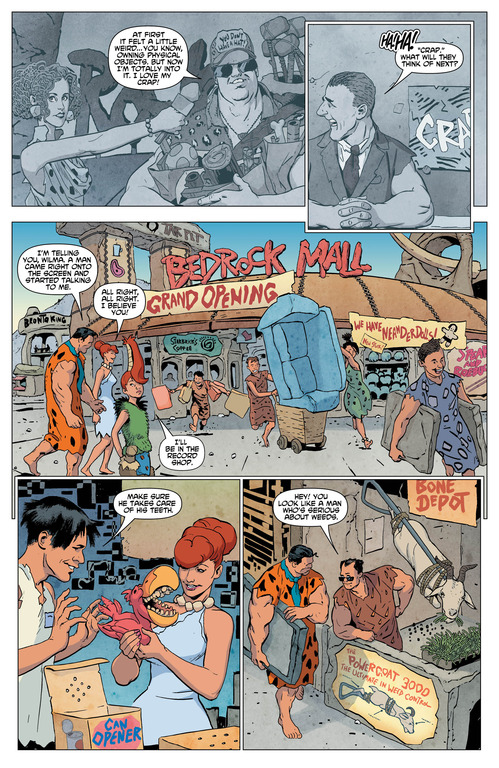
The Flintstones #2 Interior Art by Steve Pugh